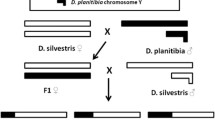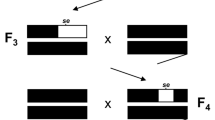Abstract
Previous studies have shown widespread conservation of gene expression levels between species of the Drosophila melanogaster subgroup as well as a positive correlation between coding sequence divergence and expression level divergence between species. Meanwhile, large-scale misregulation of gene expression level has been described in interspecific sterile hybrids between D. melanogaster, D. simulans, D. mauritiana, and D. sechellia. Using data from gene expression analysis involving D. simulans, D. melanogaster, and their hybrids, we observed a significant positive correlation between protein sequence divergence and gene expression differences between hybrids and their parental species. Furthermore, we demonstrate that underexpressed misregulated genes in hybrids are evolving more rapidly at the protein sequence level than nonmisregulated genes or overexpressed misregulated genes, highlighting the possible effects of sexual and natural selection as male-biased genes and nonessential genes are the principal gene categories affected by interspecific hybrid misregulation.


Similar content being viewed by others
References
Al-Shahrour F, Diaz-Uriarte R, Dopazo J (2004) FatiGO: a web tool for finding significant associations of Gene Ontology terms with groups of genes. Bioinformatics 20:578–580
Barbash DA, Awadalla P, Tarone AM (2004) Functional divergence caused by ancient positive selection of a Drosophila hybrid incompatibility locus. PLoS Biol 2:e142
Barbash DA, Lorigan JG (2007) Lethality in Drosophila melanogaster/Drosophila simulans species hybrids is not associated with substantial transcriptional misregulation. J Exp Zool B Mol Dev Evol 308:74–84
Castillo-Davis CI, Hartl DL, Achaz G (2004) cis-Regulatory and protein evolution in orthologous and duplicate genes. Genome Res 14:1530–1536
Coyne JA, Orr HA (2004) Speciation. Sinauer Associates, Sunderland, MA
Dobzhansky T (1936) Studies on hybrid sterility. II. Localization of sterility factors in Drosophila pseudoobscura hybrids. Genetics 21:113–135
Drosophila 12 Genomes Consortium (2007) Evolution of genes and genomes on the Drosophila phylogeny. Nature 450:203–218
Eyre-Walker A (2006) The genomic rate of adaptive evolution. Trends Ecol Evol 21:569–575
Gilad Y, Rifkin SA, Bertone P, et al. (2005) Multi-species microarrays reveal the effect of sequence divergence on gene expression profiles. Genome Res 15:674–680
Gilad Y, Oshlack A, Rifkin SA (2006) Natural selection on gene expression. Trends Genet 22:456–461
Giot L, Bader JS, Brouwer C, et al. (2003) A protein interaction map of Drosophila melanogaster. Science 302:1727–1736
Good JM, Hayden CA, Wheeler TJ (2006) Adaptive protein evolution and regulatory divergence in Drosophila. Mol Biol Evol 23:1101–1103
Hahn MW, Kern AD (2006) Comparative genomics of centrality and essentiality in three eukaryotic protein-interaction networks. Mol Biol Evol 22:803–806
Haerty W, Singh RS (2006) Gene regulation divergence is a major contributor to the evolution of Dobzhansky-Muller incompatibilities between species of Drosophila. Mol Biol Evol 23:1707–1714
Haerty W, Jagadeeshan S, Kulathinal RJ, et al. (2007) Evolution in the fast lane: rapidly evolving sex-related genes in Drosophila. Genetics (in press)
He X, Zhang J (2006) Why do hubs tend to be essential in protein networks? PLoS Genet 2:e88
Jagadeeshan S, Singh RS (2005) Rapidly evolving genes of Drosophila: differing levels of selective pressure in testis, ovary, and head tissues between sibling species. Mol Biol Evol 22:1793–1801
Johnson NA, Porter AH (2007) Evolution of branched regulatory genetic pathways: directional selection on pleiotropic loci accelerates developmental system drift. Genetica 129:57–70
Johnson NA, Porter AH (2000) Rapid speciation via parallel, directional selection on regulatory genetic pathways. J Theor Biol 205:527–542
Lemos B, Meiklejohn CD, Caceres M, et al. (2005) Rates of divergence in gene expression profiles of primates, mice, and flies: stabilizing selection and variability among functional categories. Evolution 59:126–137
Meiklejohn CD, Parsch J, Ranz JM, et al. (2003) Rapid evolution of male-biased gene expression in Drosophila. Proc Natl Acad Sci USA 100:9894–9899
Michalak P, Noor MA (2003) Genome-wide patterns of expression in Drosophila pure species and hybrid males. Mol Biol Evol 20:1070–1076
Michalak P, Noor MA (2004) Association of misexpression with sterility in hybrids of Drosophila simulans and D. mauritiana. J Mol Evol 59:277–282
Moehring AJ, Teeter KC, Noor MA (2007) Genome-wide patterns of expression in Drosophila pure species and hybrid males. II. Examination of multiple-species hybridizations, platforms, and life cycle stages. Mol Biol Evol 24:137–145
Moses AM, Pollard D, Nix DA, et al. (2006) Large-scale turnover of functional transcription factor binding sites in Drosophila. PloS Comp Biol 2:e130
Muller HJ (1942) Isolating mechanisms, evolution, and temperature. Biol Symp 6:71–125
Nuzhdin SV, Wayne ML, Harmon KL, et al. (2004) Common pattern of evolution of gene expression level and protein sequence in Drosophila. Mol Biol Evol 21:1308–1317
Ortiz-Barrientos D, Counterman BA, Noor MA (2007) Gene expression divergence and the origin of hybrid dysfunctions. Genetica 129:71–81
Oshlack A, Chabot AE, Smyth GK et al (2007) Using DNA microarrays to study gene expression in closely related species. Bioinformatics 23:1235–1242
Presgraves DC, Stephan W (2007) Pervasive adaptive evolution among interactors of the Drosophila hybrid inviability gene, Nup96. Mol Biol Evol 24:306–314
Presgraves DC, Balagopalan L, Abmayr SM, et al. (2003) Adaptive evolution drives divergence of a hybrid inviability gene between two species of Drosophila. Nature 423:715–719
R Development Core Team (2004) R: A language and environment for statistical computing. R Foundation for Statistical Computing, Vienna, Austria (ISBN 3-900051-00-3)
Ranz JM, Castillo-Davis CI, Meiklejohn CD, et al. (2003) Sex-dependent gene expression and evolution of the Drosophila transcriptome. Science 300:1742–1745
Ranz JM, Namgyal K, Gibson G, et al. (2004) Anomalies in the expression profile of interspecific hybrids of Drosophila melanogaster and Drosophila simulans. Genome Res 14:373–379
Rifkin SA, Kim J, White KP (2003) Evolution of gene expression in the Drosophila melanogaster subgroup. Nat Genet 33:138–144
Rifkin SA, Houle D, Kim J, et al. (2005) A mutation accumulation assay reveals a broad capacity for rapid evolution of gene expression. Nature 438:220–223
Schütt C, Nöthiger R (2000) Structure, function and evolution of sex-determining systems in Dipteran insects. Development 127:667–677
Singh RS, Kulathinal RJ (2000) Sex gene pool evolution and speciation: a new paradigm. Genes Genet Syst 75:119–130
Swanson WJ, Vacquier VD (2002) The rapid evolution of reproductive proteins. Nat Rev Genet 3:137–144
Thompson JD, Higgins GD, Gibson TJ (1994) CLUSTAL W: improving the sensitivity of progressive multiple sequence alignment through sequence weighting, position-specific gap penalties and weight matrix choice. Nucleic Acids Res 22:4673–4680
Ting CT, Tsaur SC, Wu ML, et al. (1998) A rapidly evolving homeobox at the site of a hybrid sterility gene. Science 282:1501–1504
Yang Z, Nielsen R (2002) Codon-substitution models for detecting molecular adaptation at individual sites along specific lineages. Mol Biol Evol 19:908–917
Author information
Authors and Affiliations
Corresponding author
Additional information
Carlo G. Artieri and Wilfried Haerty contributed equally to this publication.
Electronic supplementary material
Rights and permissions
About this article
Cite this article
Artieri, C.G., Haerty, W. & Singh, R.S. Association Between Levels of Coding Sequence Divergence and Gene Misregulation in Drosophila Male Hybrids. J Mol Evol 65, 697–704 (2007). https://doi.org/10.1007/s00239-007-9048-2
Received:
Revised:
Accepted:
Published:
Issue Date:
DOI: https://doi.org/10.1007/s00239-007-9048-2




